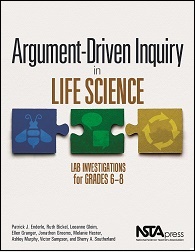Argument-Driven Inquiry in Life Science
By Carole Hayward
Posted on 2015-08-18
 In the new NSTA Press book Argument-Driven Inquiry in Life Science: Lab Investigations for Grades 6-8, 20 lab activities present an innovative approach to lab instruction called argument-driven inquiry (ADI). Use of these labs can help teachers align their instruction with current recommendations for making life science more meaningful for students and more effective for teachers.
In the new NSTA Press book Argument-Driven Inquiry in Life Science: Lab Investigations for Grades 6-8, 20 lab activities present an innovative approach to lab instruction called argument-driven inquiry (ADI). Use of these labs can help teachers align their instruction with current recommendations for making life science more meaningful for students and more effective for teachers.
Authors Patrick Enderle, Ruth Bickel, Leeanne Gleim, Ellen Granger, Jonathon Grooms, Melanie Hester, Ashley Murphy, Victor Sampson, and Sherry Southerland organize the labs around four Life Science core ideas, providing introductory and application labs for each.
- From Molecules to Organisms: Structures and Processes
- Ecosystems: Interactions, Energy, and Dynamics
- Heredity: Inheritance and Variations in Traits
- Biological Evolution: Unity and Diversity
Section 1 of the book begins with two chapters describing the ADI instructional model and the development and components of the ADI lab investigations. Sections 2–5 contain the lab investigations, including notes for the teacher, student handouts, and checkout questions. Section 6 contains four appendixes with connections to the NGSS timeline, proposal options for the investigations, and a form for assessing the investigation reports.
Here are a few examples of the lab investigations:
From Molecules to Organisms: Structures and Processes
Introduction Lab
- Cellular Respiration: Do Plants Use Cellular Respiration to Produce Energy?
Application Lab
- Osmosis: How Does the Concentration of Salt in Water Affect the Rate of Osmosis?
Ecosystems: Interactions, Energy, and Dynamics
Introduction Lab
- Population Growth: What Factors Limit the Size of a Population of Yeast?
Application Lab
- Food Webs and Ecosystems: Which Member of an Ecosystem Would Affect the Food Web the Most if Removed?
Heredity: Inheritance and Variation in Traits
Introduction Lab
- Variation in Traits: How Do Beetle Traits Vary Within and Across Species?
Application Lab
- Mechanisms of Inheritance: How Do Fruit Flies Inherit the Sepia Eye Color Trait?
Biological Evolution: Unity and Diversity
Introduction Lab
- Mechanisms of Evolution: Why Does a Specific Version of a Trait Become More Common in a Population Over Time?
Application Lab
The ADI instructional model focuses on authentic lab activities so that students have more experiences engaging in scientific practices such as asking questions and defining problems, developing and using models, and analyzing and interpreting data. This type of instruction requires that students receive feedback and learn from their mistakes so they can incorporate their new knowledge and experiences into future labs and investigations. The ADI activities presented in this book are thoughtfully constructed to help students learn science in authentic contexts and also to develop the required knowledge, skills, abilities, and habits of mind to do science.
This book is also available as an e-book. To learn more, visit the Argument-Driven Inquiry Series page.
The mission of NSTA is to promote excellence and innovation in science teaching and learning for all.
Follow NSTA
Disclaimer: The views expressed in this blog post are those of the author(s) and do not necessarily reflect the official position of the National Science Teaching Association (NSTA).

